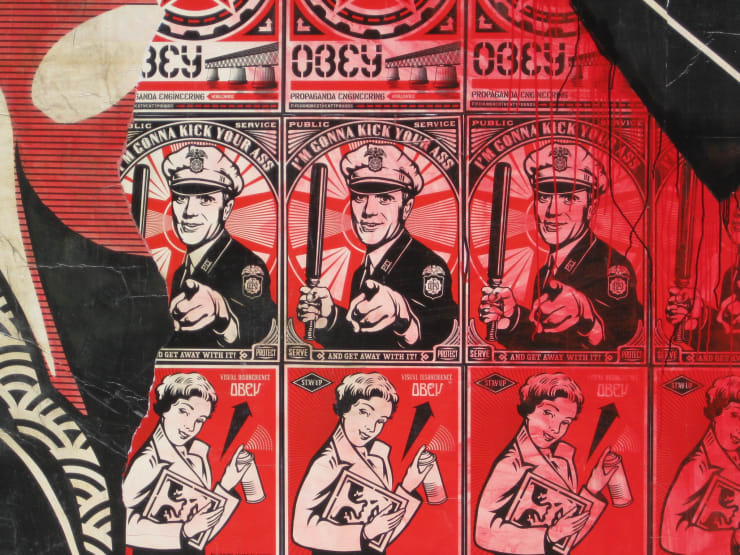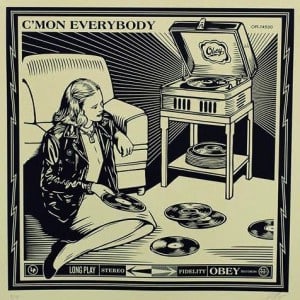Shepard Fairey
-
 Shepard FaireyPower Bidder, 2015Three-color relief on handmade paper34 1/2 x 25 1/2 ins 87.63 x 64.77 cmSigned and numbered by the artist in Pencil. Marked TP.
Shepard FaireyPower Bidder, 2015Three-color relief on handmade paper34 1/2 x 25 1/2 ins 87.63 x 64.77 cmSigned and numbered by the artist in Pencil. Marked TP. -
 Shepard FaireyTime To Move On, 2015Screenprint24 x 18 ins 60.96 x 45.72 cm
Shepard FaireyTime To Move On, 2015Screenprint24 x 18 ins 60.96 x 45.72 cm -
 Shepard FaireyUnsinkable Consumption, 2015Silksceen24 x 18 ins 60.96 x 45.72 cm
Shepard FaireyUnsinkable Consumption, 2015Silksceen24 x 18 ins 60.96 x 45.72 cm -
 Shepard FaireyBurroughs 100 Years, 2014Screenprint24 x 18 ins 60.96 x 45.72 cm
Shepard FaireyBurroughs 100 Years, 2014Screenprint24 x 18 ins 60.96 x 45.72 cm -
 Shepard FaireyC'mon Everybody, 2014One color serigraph with one color varnish42 x 42 ins 106.68 x 106.68 cm
Shepard FaireyC'mon Everybody, 2014One color serigraph with one color varnish42 x 42 ins 106.68 x 106.68 cm -
 Shepard FaireyClassic Discs, 2014One color serigraph with one color varnish42 x 42 ins 106.68 x 106.68 cmSigned and numbered in pencil
Shepard FaireyClassic Discs, 2014One color serigraph with one color varnish42 x 42 ins 106.68 x 106.68 cmSigned and numbered in pencil -
 Shepard FaireyKnow Your Rights, 2014One color serigraph with one color varnish42 x 42 ins 106.68 x 106.68 cm
Shepard FaireyKnow Your Rights, 2014One color serigraph with one color varnish42 x 42 ins 106.68 x 106.68 cm -
 Shepard FaireyThe Human Trial, 2013Screenprint24 x 18 ins 60.96 x 45.72 cm
Shepard FaireyThe Human Trial, 2013Screenprint24 x 18 ins 60.96 x 45.72 cm -
 Shepard FaireyDove Target Red, 2012Three-color relief on handmade paper35 x 25 1/2 ins 88.9 x 64.77 cmHand signed and dated in pencil lower right. Numbered lower left.
Shepard FaireyDove Target Red, 2012Three-color relief on handmade paper35 x 25 1/2 ins 88.9 x 64.77 cmHand signed and dated in pencil lower right. Numbered lower left. -
 Shepard FaireySonic Solutions Inc. (Mea Culpa), 20083-D screenprint24 x 18 ins 60.96 x 45.72 cmHand signed and dated lower right
Shepard FaireySonic Solutions Inc. (Mea Culpa), 20083-D screenprint24 x 18 ins 60.96 x 45.72 cmHand signed and dated lower right
Shepard Fairey
For the majority of people, Pop Artist Shepard Fairey appeared to become famous “overnight,” as the highly stylized Barack Obama HOPE poster he created during the 2008 presidential election season went viral and became omnipresent as the campaign gained momentum. At the time, “hope” was considered to be a cornerstone of the Obama campaign and Fairey’s poster quickly became the predominant visual element used by Obama supporters – as campaign posters, bumper stickers, t-shirts and other forms of paraphernalia. Other versions of the unique portrait were created with the words “PROGRESS,” “CHANGE” and “VOTE” used in place of “HOPE.”
Due in large part to the enormous success of Barack Obama’s 2008 presidential campaign, Shepard Fairey’s HOPE poster became an American classic, earning its place in history as an iconic piece of presidential campaign art. Following the election, the Smithsonian Institution’s U.S. National Portrait Gallery acquired HOPE, where it resides as part of the gallery’s permanent collection.
The argument that most lawmakers make about graffiti is that it’s illegal because it’s an eyesore, but you could easily argue that a lot of advertising is an eyesore.”
– Shepard Fairey
For the majority of people, Pop Artist Shepard Fairey appeared to become famous “overnight,” as the highly stylized Barack Obama HOPE poster he created during the 2008 presidential election season went viral and became omnipresent as the campaign gained momentum. At the time, “hope” was considered to be a cornerstone of the Obama campaign and Fairey’s poster quickly became the predominant visual element used by Obama supporters – as campaign posters, bumper stickers, t-shirts and other forms of paraphernalia. Other versions of the unique portrait were created with the words “PROGRESS,” “CHANGE” and “VOTE” used in place of “HOPE.”
Due in large part to the enormous success of Barack Obama’s 2008 presidential campaign, Shepard Fairey’s HOPE poster became an American classic, earning its place in history as an iconic piece of presidential campaign art. Following the election, the Smithsonian Institution’s U.S. National Portrait Gallery acquired HOPE, where it resides as part of the gallery’s permanent collection.
Shepard Fairey’s Early Years
The roots of Shepard Fairey’s artistic inclinations took shape during the 1980s, as a teenager on the streets of Charleston, SC. Born in 1970, the artist grew up in a relatively conservative home, with his father a practicing doctor and his mother, a realtor. Shepard describes his powerful Charleston influences to be those developed as a part of the “skateboard” scene – a culture that included a passion for punk rock bands and a bend toward anti-establishment political views. For Shepard Fairey, there was a keen awareness of the power of the art that accompanied and fueled the scene. Street art (graffiti), skateboard graphics and punk rock album covers all would have a strong influence on the emerging style of Shepard Fairey. By the mid-eighties, Fairey was applying his own designs to skateboards and t-shirts.
During this same time, Fairey also took note of the works of famous Pop and Contemporary Artists – such as Andy Warhol, Roy Lichtenstein and Robert Rauschenberg – appreciating the artists’ abilities to provide social commentary, hold a mirror to American culture and push the boundaries of art.
After graduating from California’s Idyllwild Arts Academy in 1988, Shepard enrolled at the Rhode Island School of Design (RISD), where he would graduate with a Bachelor of Fine Arts degree in 1992.
Obey Giant Campaign Flexes Street Art Muscle
As a student at RISD in 1989, Shepard Fairey developed a grassroots sticker campaign designed to gain the artist notoriety and demonstrate to the power and reach of street art. Shepard Fairey produced stickers featuring an Illustration of professional wrestler “Andre the Giant” sourced from the Weekly World News tabloid publication. Fairey’s design added the words, “Has A Posse” beneath wrestler’s name – lending a potential of the cryptic words alluding to a larger meaning. For Shepard Fairey, this experimental campaign became an overwhelming success. The stickers were being placed in public spaces, including on street signs and building, initially in the area of Providence, RI, but shortly thereafter in various northeastern cities.
A key takeaway for the artist was that Fairey’s intuition about the appeal of fringe crossover ideology could indeed communicate something intrinsically fascinating – capable of fueling viral advertising. It was also gratifying for the artist to see elements of his brand, his signature black, grey and red color palette – beginning to grow along with the popularity of his work. The campaign has continued to evolve into Fairey’s most self-defining works – and is currently referred to primarily as the OBEY campaign. Shepard Fairey maintains www.obeygiant.com – a website devoted to communicating the philosophies for the campaign. The website store sells OBEY stickers, including those that feature various illustrations of the face, or part of the face of Andre the Giant, encouraging people to continue to disseminate the message and join “the posse.” The OBEY campaign also promotes other symbols associated with Fairey’s brand, many that borrow or convey a similar feeling to internationally used government and anti-government symbolism.
Street Credibility Fuels Commercial Success
Over the past three decades, Shepard Fairey has achieved significant commercial success working with brands that identify with and/or seek to leverage the power of his unique rebellious style. In 1997, Fairey became a founding partner of a design firm called BLK/MRKT Inc., which developed iconic marketing campaigns for large brands, including Pepsi and Internet browser Netscape.
In 2003, along with his wife Amanda Fairey, Shepard founded Studio Number One – an agency that worked with top talent in the music and entertainment industry. The studio developed album covers for The Black Eyed Peas, The Smashing Pumpkins and Led Zeppelin. They also designed a poster for highly acclaimed film entitled Walk the Line, about the life of Johnny Cash.
In 2006, Shepard Fairy accepted a position as the founding Creative Director for Project 2050, and NYC advertising agency, where he helped to develop campaigns for large brands including Virgin and Boost Mobile.
In addition to his agency work, Fairey continuously works on solo art projects and collaborations with musicians, filmmakers and other artists – frequently on social and political campaigns that align with his interests and beliefs. Considered by many to be one of the world’s most influential street artists, Shepard Fairey’s works are included within collections in prestigious museums around the world, including the Museum of Modern Art (NYC), the Los Angeles County Museum of Art, the Museum of Contemporary Art San Diego and the Victoria and Albert Museum in London.
motherjones.com/politics/2008/03/interview-shepard-fairey
trbimg.com/img-504a926d/turbine/la-ap-poster-artist-jpeg-0f2a8.jpg-20120907/600
-

Damien Hirst, Shepard Fairey and Invader Together in London
Heist in Damien Hirst's London Studio November 5, 2025The works of Damien Hirst , Shepard Fairey and French street artist Invader are being shown together at the Newport Street Gallery in London. Although...Read more -

The Good Business of Andy Warhol's Screenprints
Bobby Grossman's Photos of Warhol at VFA May 15, 2025An exhibit at the Andy Warhol Museum explores the artist’s extensive use of screenprinting. Warhol generated thousands of screenprints during his career, both at The...Read more -

VFA at Art Miami 2023
November 29, 2023Vertu Fine Art will be exhibiting the finest Modern and Contemporary art at Art Miami 2023. The 33rd Edition of Art Miami 2023 runs from...Read more -

Alex Katz in Fashion, Shepard Fairey Honors Muhammed Ali
Barbie Pink Pops Out On the Walls at VFA July 26, 2023Alex Katz is a consummate New Yorker. He was born in Brooklyn, raised in Queens, studied at Cooper Union in Manhattan and has been living...Read more -

Shepard Fairey: Salad Days, Robert Plant & Beyond
July 2, 2018Shepard Fairey said that Punk Rock and skateboarding saved his life. That sounds very dramatic, but the influence of music and skateboarding led Fairey to become one of the world’s most recognizable street artists.Read more -

Shepard Fairey’s Cautionary Tone Hits All The Low Notes
October 3, 2014A recently acquired Shepard Fairey serigraph , Endless Power , consistently puts smiles on the faces of viewers who appreciate the Pop Artist’s wry sense...Read more -

Shepard Fairey: Dissent Goes Pop
June 23, 2014Before the Internet became mainstream media and Web 2.0 social channels made content sharing an everyday cultural norm, innovative young artists like Shepard Fairey relied on Word of Mouth advertising to launch “viral” campaigns. Like Pop Artist Keith Haring, who took to Manhattan’s subway stations to garner exposure for his early works, Shepard Fairey employed street tactics to plant seeds of inquiry about the nature of his artistic intentions. In 1989, while a student at the Rhode Island School of Design, Fairey stumbled upon viral success with a sticker he designed and disseminated – bearing the likeness of professional wrestler Andre The Giant.Read more


















